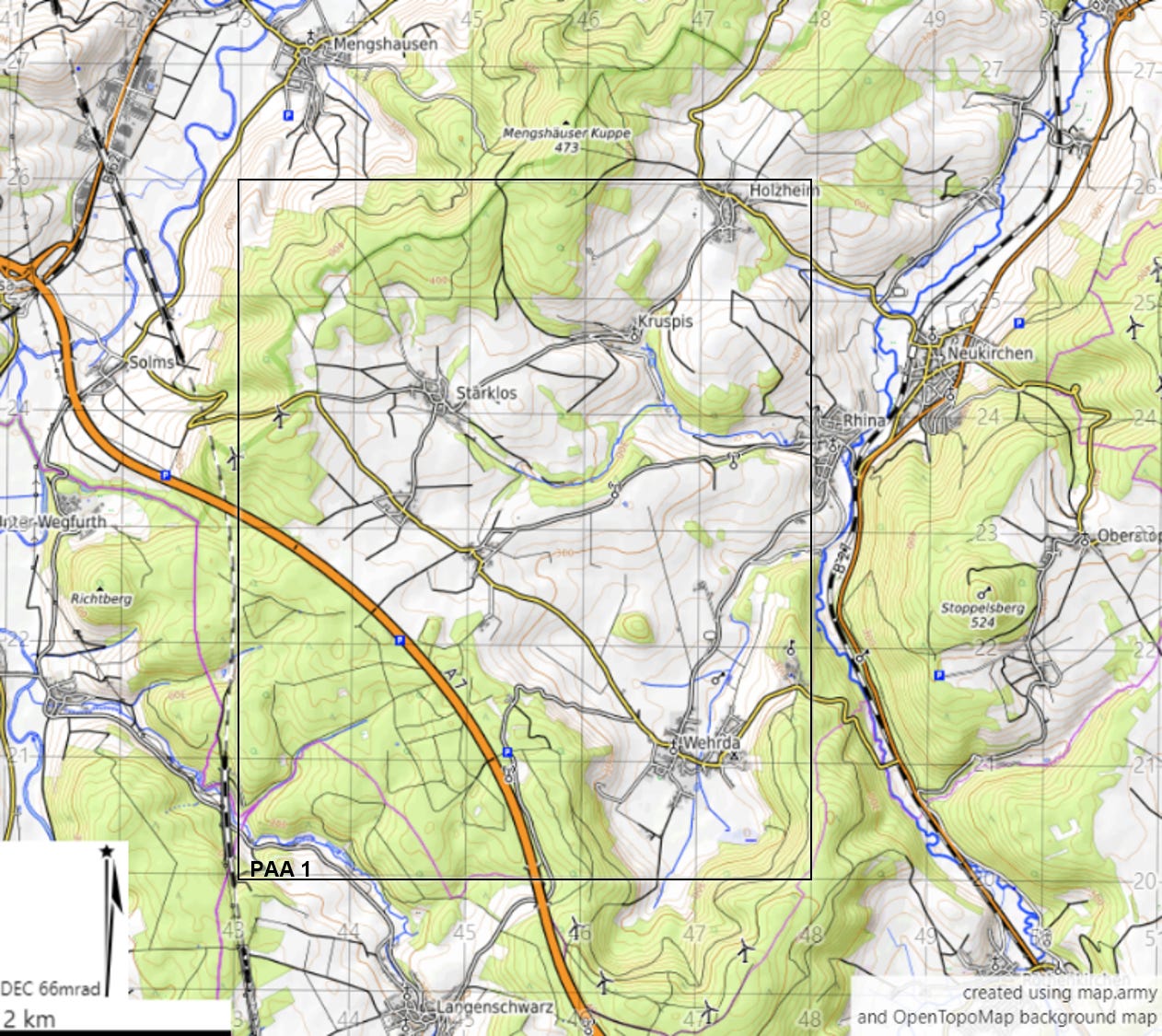You are the Platoon Commander, 1st Platoon, Battery S, Battalion Landing Team 1/6. Your Platoon has 3x M142 HIMARS Launchers. You have 2 Mk-19 automatic grenade launchers, 3 M2A1 heavy machine guns, and 8 M240B medium machine guns at your disposal. You have 4 Light Tactical Vehicles and 2 Medium Tactical Vehicles with turrets. Your HIMARS and Resupply Systems have mounts for machine guns but lack turrets for protection.
Your platoon is supporting the Battalion Landing Team’s defense of Geisa, where a Motorized Company (Reinforced) intends to rupture the US defense and push on to Fulda, 12 km south of Hunfeld. Reports over the last week include EN recon (5 km E of PAA 1) and Special Operations Forces (SOF) interrogating locals (5 km S of PAA 1). The SOF elements are suspected of having demolitions and sabotage equipment, as well as possible Improvised Explosive Device materials. Enemy artillery consists of a 2S19 Battery that has been known to fire cluster munitions. The enemy also has a Pork Trough-2 Counterbattery Radar, but always verifies its targeting data with Unmanned Aerial Systems prior to counterfire. The local populace is mostly friendly to the US cause.

You received a movement order to Position Area of Artillery (PAA) 1 with an Azimuth of Fire of 1600 in order to meet a two-launcher Time on Target (TOT) mission, 90 minutes from now. You and the rest of the Advanced Party have just entered PAA 1 from the South and the rest of your platoon is 30 minutes behind you.
Within the next 15 minutes, write/draw out your occupation plan and local security plan. Include all relevant unit locations, tactical control measures, and priorities of work.

Scroll down for learning points
-
-
-
-
-
-
Learning Points
Mission oriented: Could your plan feasibly lay the battery in time to meet the TOT? Are you defending an engagement area or preparing to protect your assets and break contact?
Threat driven: What drove your decisions? What threats were you most concerned about?
All arms of artillery: How do meteorology, survey, communications, motor transport, and ammunition fit into your plan?
Task Organization: Does your emplacement plan require you to change the way you Task Organize the platoon?
Survivability Factors (J.B.A. Bailey, Chapter 12)
Equipment mobility. How stuck in the terrain are you? Do you have an egress route? Have you sacrificed mobility for physical protection? Was the that deliberate?
Frequency of movement. What are your triggers to move? Do you have a rally point or alternate position planned?
Protection
Dispersion. What threat is your dispersion based on? Is it feasible with our equipment capabilities?
Natural protection. How well do you use terrain to your advantage?
Artificial protection. Are deliberate/hasty construction built into your priorities of work? How well do you use the armor of your vehicles?
Self defense. Where did you choose to focus and where did you accept risk? Are the routes into and out of the position covered? Have you built depth with LP/OPs?
Deception
Fire Control. Did you plan to move after your TOT? Did you consider a roving gun or an offset registration?
Visual betrayal. Did you mask your launchers with terrain? How do you quickly move away from a smoke trail after firing? Did you mask your force from the local populace?
Electromagnetic Spectrum. How does the need for command and control balance with EM signature management? How can you mitigate it?
Camouflage. Did you use the wooded areas?
Other Tactical Fundamentals
Fundamentals of the Defense Principles of MG Employment
-Knowledge of the enemy -Pairs
-Maneuver -Interlocking Fires
-Preparation: Hasty and Deliberate -Coordination of Fires
-Use of Terrain -Mutual Support
-Surprise -Defilade
-Mass and Concentration -Enfilade
-Flexibility -Economy
-Offensive Action -Protection
-Mutual Support
-Defense in Depth 



